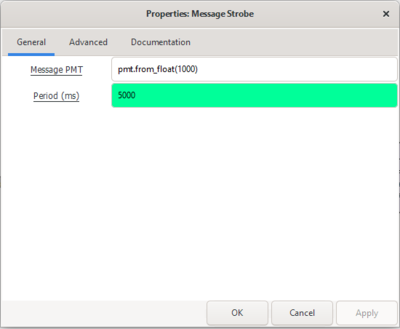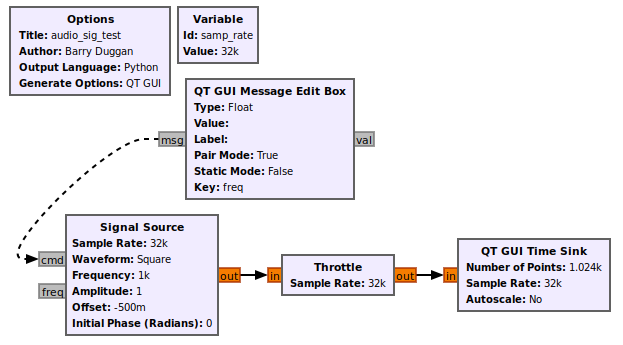Signal Source: Difference between revisions
Jump to navigation
Jump to search
| Line 43: | Line 43: | ||
: For GNU Radio 3.8, the messages dont work correctly with pairs, but they do work fine with a dictionary. This issue is explained [https://github.com/gnuradio/gnuradio/issues/4239 here]. | : For GNU Radio 3.8, the messages dont work correctly with pairs, but they do work fine with a dictionary. This issue is explained [https://github.com/gnuradio/gnuradio/issues/4239 here]. | ||
: For GNU Radio 3.8, the amplitude of the signal source can be changed to 0.5 by adding the following PMT to the message strobe block. | : For GNU Radio 3.8, the amplitude of the signal source can be changed to 0.5 by adding the following PMT to the message strobe block. | ||
: <syntaxhighlight lang="python"> | |||
: pmt.dict_add(pmt.make_dict(), pmt.intern("ampl"), pmt.from_double(0.5)) | : pmt.dict_add(pmt.make_dict(), pmt.intern("ampl"), pmt.from_double(0.5)) | ||
This PMT creates a dictionary and adds a pmt pair of ("ampl", 0.5) to the dictionary. | : </syntaxhighlight> | ||
: This PMT creates a dictionary and adds a pmt pair of ("ampl", 0.5) to the dictionary. | |||
; freq | ; freq | ||
Revision as of 07:16, 29 December 2021
Signal generator: generates a variety of waveforms.
Supports an output of type complex, float, int, and short
Parameters
(R): Run-time adjustable
- Sample Rate (R)
- Default value: samp_rate
- Sample rate (fs) is the average number of samples obtained in one second. Its units are samples per second or hertz e.g. 48,000 sample rate is 48 kHz.
- Waveform (R)
- options: [Constant, Sine, Cosine, Square, Triangle, Saw Tooth]
- For selection with a variable, the following values should be used:
* Constant = 100 * Sine = 101 * Cosine = 102 * Square = 103 * Triangle = 104 * Sawtooth = 105
- Frequency (R)
- Frequency of the waveform (default: 1000)
- Amplitude (R)
- Amplitude of the output (default: 1)
- Offset (R)
- Offset from zero (default: 0)
- Initial Phase (Radians) (R)
- Default: 0
Message Ports
- cmd
- The 'cmd' message port accepts message pairs.
- 'freq' . float value
- 'ampl' . float value
- 'phase' . float value
- 'offset' . float value
- For GNU Radio 3.8, the messages dont work correctly with pairs, but they do work fine with a dictionary. This issue is explained here.
- For GNU Radio 3.8, the amplitude of the signal source can be changed to 0.5 by adding the following PMT to the message strobe block.
: pmt.dict_add(pmt.make_dict(), pmt.intern("ampl"), pmt.from_double(0.5)) :
- This PMT creates a dictionary and adds a pmt pair of ("ampl", 0.5) to the dictionary.
- freq
- The value of frequency in the signal source can be changed by connecting a message strobe. The Message PMT parameter can be set to pmt.from_float(new_freq). In this way, the frequency of the signal source will be changed to new_freq value after the specified period in the message strobe. In the following example, the frequency of the signal source is changed to 1kHz after 5 seconds.
- The 'freq' message port has been
deprecated in 3.9in favor of the 'cmd' message port.
Example Flowgraph
This flowgraph is for version 3.9+.
Example Output
Types of Waveforms:
Cosine (complex):
Constant:
Square:
Triangle:
Sawtooth:
Source Files
- C++ files
- [1]
- Header files
- [2]
- Block definition
- [3]







